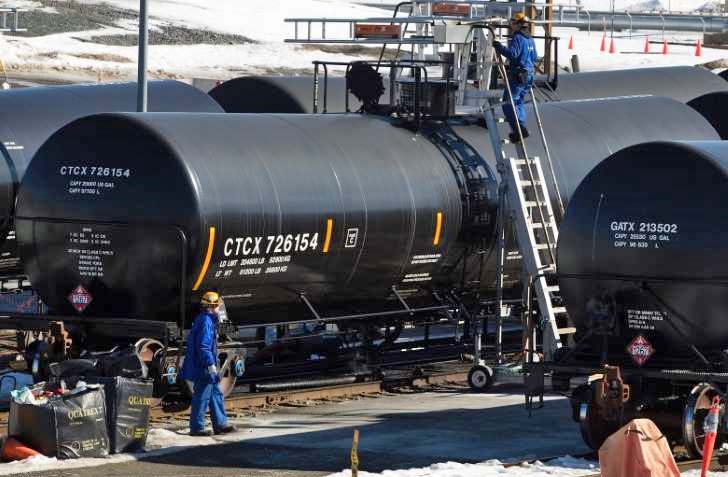
Alberta - With no capacity to spare on pipelines out of Alberta, oil patch leaders are desperately waiting for when they'll be able to ship
more crude on rail lines.
Imperial Oil reduced oil sands operations in recent months as the company had no way of sending oil to market.
In the first quarter of this year, production was pulled back by about 12,000 barrels per day.
"On any given day, we had capacity to produce, but no place to put the oil," said Imperial Oil CEO Rich Kruger to journalists at the company's annual
general meeting in Calgary on 27 Apr 2018.
"We had to curtail, it was not discretionary, we had to because there was no place to put it."
Husky Energy temporarily scaled back production by 5,000 barrels a day and Cenovus decided to fluctuate its production to produce less when limited pipeline
space lowered prices in the province.
Pipelines are the preferred method of shipping oil because they are cheaper and faster in getting product to refineries.
However, both rail and pipelines are strained right now, leaving companies struggling to export oil.
Export Woes
Existing pipeline space is full and new pipelines are delayed, such as Kinder Morgan's Trans Mountain expansion, Enbridge's Line 3 replacement, and
TransCanada's Keystone XL.
Meanwhile, Canada's largest railways aren't able to cash in on servicing the oil patch since they are grappling with too much existing freight after an above
average grain harvest last fall and unusually tough winter weather.
The rail backlog is expected to clear in the latter half of this year, when oil companies can start loading up significantly more tank cars.
"Rail provides a bridge," said Cenovus CEO Alex Pourbaix, until new export pipelines are constructed.
Pourbaix said Alberta currently needs between 100,000 and 300,000 barrels per day of new pipeline space, a figure that will only grow as new oilsands projects
like Suncor's Fort Hills project reach full production.
Alberta has oil rail terminal loading capacity of about 600,000 barrels per day and is currently shipping about 100,000 barrels per day, said
Pourbaix.
The Cenovus CEO said he's currently negotiating with CN and CP and expects to spend between $14 and $18 US per barrel, when all of the rail costs are
considered.
The transportation constraints are the main reason why oil prices in Alberta are substantially lower compared with those for the rest of the
continent.
Alberta's Western Canada Select (WCS) was selling for around $30 US per barrel less than West Texas Intermediate (WTI), the North American benchmark, in
February.
The WCS-WTI differential has since narrowed to about $17, but is still far from the usual average of about $10.
Solid Bitumen Safer to Carry
The longer the oil patch waits for new pipelines to be constructed, the more the industry looks at new ways of exporting, such as shipping raw bitumen in solid
form by rail.
"That's a very, very, doable technology. It is not at all experimental, it is completely commercial," said Pourbaix.
"The only thing the industry would have to do is make an investment in processing units to take the diluent out of the product before we put it into
railcars."
This shipping method could be less dangerous in a spill compared with sending liquid crude oil.
"Because you are moving undiluted bitumen, you don't have any of the environmental issues," said Pourbaix.
"The product solidifies in the tank cars and is actually inert."
The expected growth in shipping crude by rail doesn't mean the oil patch is giving up on new pipeline projects.
Company executives continue to say they are confident new pipes will be built.
If not, growth plans may be shelved.
"For this industry to grow, we need expanded market access," said Imperial's Kruger.
"It will be a big part of our deliberations and considerations of any new expansions."
Kyle Bakx.
under the provisions in
Section 29 of the Canadian
Copyright Modernization Act.


